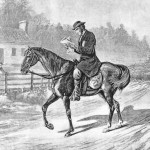President Theodore Roosevelt called it “the most American thing in America.” With its passing, it’s been said, “the American middle class in the interior lost something valuable.” The Chautauqua movement brought religion, politics, culture and entertainment to small towns and rural outposts across the United States from the 1870s through the 1920s. After the establishment of a family bible camp on a lake in western New York State in 1874, the concept of the Chautauqua was rapidly reinterpreted around the country. In a few years, Dr. A. H. Gillett organized Indiana’s Western Chautauqua in northern Noble County as a conference for Methodist Sunday School teachers.
In time, the Western Chautauqua expanded in scope to interdenominational and secular offerings. Otherwise known as the Island Park Assembly, the grounds were located on Sylvan Lake’s Kerr Island, connected by bridge to Rome City. Unlike the so-called “tent” or “circuit” Chautauquas of the era, the Island Park Assembly was a permanent fixture, boasting, in its heyday, formal gardens, brilliant electric illumination, a hall seating 2500, a museum and classrooms, where children learned about art, music, language and scripture. During the annual gathering, which began in late July and lasted for three weeks, visitors might hear an address by three-time Democratic presidential candidate William Jennings Bryan. Other speakers included temperance crusader Sam Jones, Hoosier poet James Whitcomb Riley, and former slave Blanche K. Bruce, the first African-American ever to serve a full term in the U.S. Senate.
Though somewhat remote, Island Park Assembly enjoyed a steady stream of visitors from across the Midwest, thanks to rail service provided by the Grand Rapids and Indiana Rail Company. The railroad, which had leased the grounds to the Western Chautauqua association, offered special excursion rates to Rome City and season passes to the summer gathering. Writing for the Grand Rapids Herald in1949, one journalist recalled the excitement of his first train trip to the assembly in the early 1890s—
It was an all-day ride by rail (and a thrilling ride) to glamorous Rome City, which I hardly noticed in the ecstatic walk from the station over a wide, banner-bedecked wooden bridge to the small island where a cottage and a tent awaited us, in a colony of neat summer residences. A modern child probably would be less impressed by a visit to Paris. On this enchanted park-like island in Sylvan Lake were an auditorium, flower-gardens and fountains, a big refreshment store with the first soda-fountain I had ever seen, and at a small landing an excursion steamer that puffed its way around the lake. About a mile out from the landing was a tiny, low-lying fairy isle, with tall trees and grass.
With the invention of the automobile—along with the advent of radio and the movies—the national Chautauqua movement began to falter. By 1906 the Western Chautauqua was already in financial straits, when legislation forced the railroad to discontinue the special rates to Rome City. The Island Park Assembly folded, and its grounds were converted into a beer garden.
For more information on Island Park Assembly, go to https://www.geocities.com/Heartland/Woods/8049/saga/bk6ch47.html






















